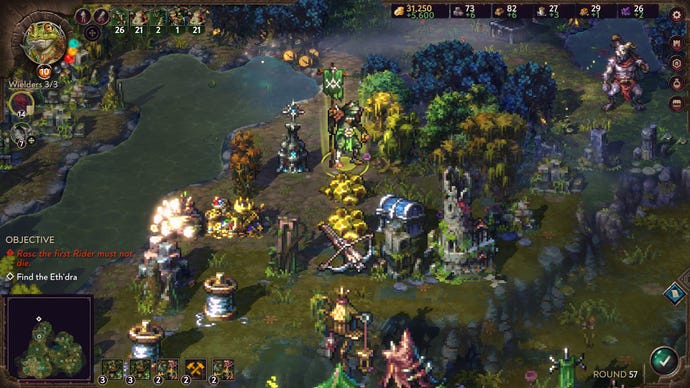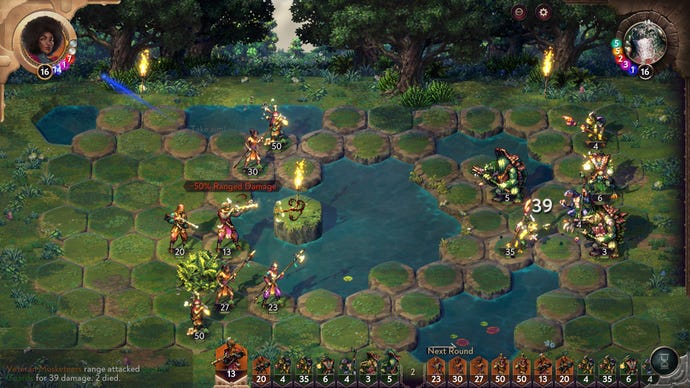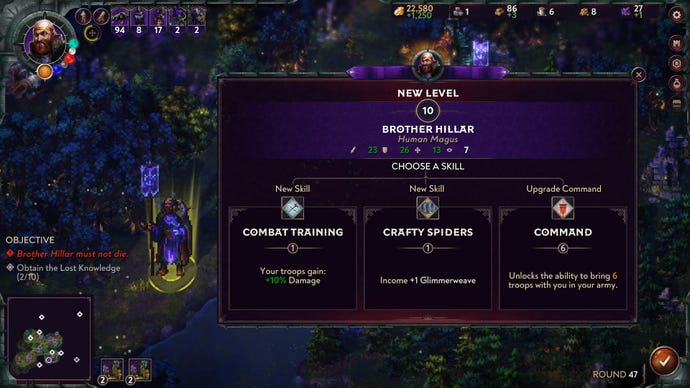Two years of early access have been kind Songs of Conquest. Its strategy fundamentals were already strong enough to impress me in 2022 that it’s been quite tricky to even remember what’s changed. But there’s more of it, and although after much reflection I think it’s not quite, quite for me, more of a good and unusual thing is definitely enough to push me into a very nearly wholehearted endorsement.
This full release is more a case of offering more for your money than dramatically expanding how it plays. Two new story campaigns take us to four (one per faction), each with four very long and elaborate levels. There are now multiple skirmish modes with preset or randomised maps (with an interesting option to have “find the object” as a win condition, tilting a game’s focus towards exploration and fighting side battles over the traditional direct massacre), and a set of challenge maps that – no thank you, my life does not need more challenges. Thanks to its editing tools, there are already a few player made campaigns and maps, too.
These are all centred on one concept: to gather a handful of magical warlords (wielders) and have them alternate between hoovering stuff up on a big world map, using that stuff to build and raise armies, and taking those armies to tell the other wielders what stupid ugly jerks they are via interpretive stabbing. Players of Heroes of Might and Magic probably don’t need the reference, but it’d be remiss not to make it.



The hoovering is the big thing, as it gives XP, resources, and artifacts to beef up your wielders. Thanks to some excellent sound effects, there’s always a tiny satisfaction in picking wood or magical rocks up even when you don’t really need them. Troves are often guarded by neutral, static armies where you can try out new tactics. Meeting hostiles triggers a turn-based mini-battle on a hex grid, where the already gorgeous and vibrant pixel art lends itself to lovely animations and effects. Even the borders feature lovely animated scenery you might never stop to notice.
Wielders don’t join the ranks, but cast spells based on the schools you’ve trained/equipped them for, powered by mana from many sources, the most significant and tactically flexible being your soldiers themselves. Each unit type generates ‘essence’ to power spells for specific schools (about half the spellbook is for multi-school spells), even if that unit is down to its last dude, which adds more tactical variety to your ability to either pile all your crossbowmen, say, into one hardy unit that can endure and distribute more damage, or to split them into two or even three weaker ones that generate more magic (and potentially bog the enemy down in melee or a slower action economy).
Your wielders’ skill bonuses apply to their whole army too, so you might specialise one for extra-powerful spellcasting, heavy melee offence, or even economics, either by passively generating resources or raiding and pillaging enemy settlements. You might even have one whose role is mostly to ferry reinforcements from your towns to your combat wielders. Map control is everything, as towns (which are static, with strictly limited building slots) are generally easily taken without a wielder in defence, but wielders sitting in defence aren’t going out earning XP and goodies. You need to be expanding and pushing always, because anything you don’t hoover up can go to the enemy instead. But they can’t be everywhere, so even a weaker side can sometimes use harassing raids and feint tactics to unnerve and undermine a stronger one.
Each faction’s unit roster is small but unique, and varied enough to resist reducing them to one gimmick or playstyle. Take the Rana, an alliance of oppressed swampy frog and lizard people, whose mix of very slow defenders and fast cavalry are backed by strong ranged spell chuckers, and spider riders who weaken adjacent enemies. They seem contradictory, because you’re not really meant to recruit everything; it’s generally better to have a large force comprised mostly of one or two key types paired with a wielder who can push their strengths further. Some troops (especially the undead faction’s) are at their best not even fighting, but sitting at the back generating extra magic for your spells.

Between which skills and magic your wielders level into, their equipment, what troops you focus on, and what opposition you’re up against, Songs of Conquest is very much a game about learning all the combinations. But as each unit has only one or two quirks, and the rules are generally clear and straightforward, it doesn’t get too overwhelming or pedantic (although the battle log is disappointingly uninformative, and it’s sometimes hard to see a hex behind a line of huge monsters, and with no order confirmation and such condensed battles, an occasional misclick can cause serious damage).
The game rewards learning your way around, but it doesn’t demand scholarship. You might, however, stack your chips all wrong and not find out until quite some way into a match (pro tip: protection against spell damage is priceless). The level up options being partly randomised works less well than in e.g. Wildermyth, partly because some skills are dramatically worse than others. A little extra wood, or more powerful magic? Are you joking.
But that variety means that taking a few knocks while you learn how to plan your forces in advance is part of the fun. And Songs of Conquest is a heap of fun. I even enjoyed the story, as each faction’s campaign centres their own conflict and throws some fresh light onto the wider one. I appreciate that there’s no bog standard Human Empire or goddamn elves. Even the undead faction are a blend of cultists, rats, and spirits, with more interesting motivation than “hey let’s awaken the Dark Lord lol oh no my soul” again. The Baryans, who could have been generic evil slavers come across like a forward thinking, curiously legalistic culture in contrast to the old kingdoms, but with a mercantile bent that means that, yeah, even their main campaign wielder was enslaved.
I like Songs of Conquest a lot. I may not quite love it, but it’s colourful and rich in flavour and has more strategic depth than at first appears. Its main inspiration is clear, but it more than earns its own place in the sun.
This review is based on a copy of the game provided by the publisher.


